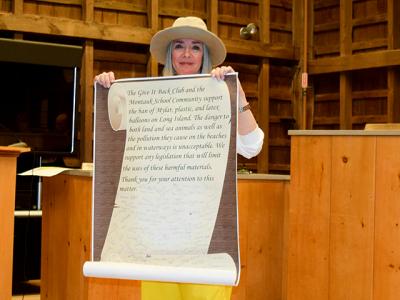East Hampton Town Bans Balloon Releases

Support for a ban on the intentional release of balloons has grown quickly in the Town of East Hampton since a town trustee first drew attention to their impact on marine wildlife, and last Thursday the town board unanimously passed a law against it.
Suffolk County allows an individual to release up to 25 balloons per day, a fact that activists advocating a ban have incredulously recounted in recent months. Balloons’ effects are often lethal, as was illustrated by one of four people who spoke in favor of a ban ahead of the vote at Thursday’s town board meeting.
“I have observed the horrific consequences of discarded balloons on marine wildlife,” Kimberly Durham, necropsy program director for the Atlantic Marine Conservation Society, told the board, recalling a year-old harbor seal rescued in Quogue “with balloon ribbon constricting and cutting deep into her neck.” This animal was lucky, she said; others are not. “Fragments of latex balloons — the rims, the ribbons, twine — are documented and archived routinely with investigations of sea turtle mortalities. In gestion, whether directly or indirectly through their food, is a major threat to New York’s marine mammals and sea turtles.”
The Atlantic Marine Conservation Society’s chief scientist scooped a balloon bearing a “Happy Father’s Day” message from Shinnecock Inlet last August, nearly two months after Father’s Day, Ms. Durham said, while several dolphins were observed nearby. “During that same survey he recovered a total of eight pounds of floating debris,” she said.
Chuck Morici, a Montauk fisherman, provided another eyewitness account, telling the board of “balloons everywhere” on the ocean surface.
Andrew Brosnan, chairman of the Eastern Long Island chapter of the Surfrider Foundation, told the board that 194 balloons were among the nearly two tons of debris he and colleagues had collected during 18 beach cleanups last year. “The legislation that is being considered here tonight is an excellent way to prevent the intentional littering of the ocean and of our beaches,” he said.
The law passed on Thursday bans the intentional release of balloons except in public or private receptacles and in designated areas at the town’s recycling centers. Balloons carrying scientific instruments or being used for governmental or meteorological purposes, hot air balloons, and balloons released indoors are exempted from the ban.
Susan McGraw Keber, a trustee, presented the board with a proclamation from the Give It Back Club at the Montauk School, where she served as a judge in a science fair. Each of the school’s students, she said, signed the proclamation, and she displayed posters students made bearing messages including “Pollution Is Bad,” “Save Sea Life,” “Do Not Pollute,” and “End Pollution, Save Lives.”
Last year, Ms. McGraw Keber, who is also an illustrator and cartoonist, designed a “balloon fish” crafted from found balloons, which she said was an effort to convey the message to children that balloons, which are popular at birthdays, weddings, and other celebrations, are hazardous to marine life. The design now adorns T-shirts that the trustees sell, with proceeds going to the Rysam Fund, a scholarship they award annually to a graduating high school student.
“The children are the ones who will protect and preserve what we have here in town,” Ms. McGraw Keber, who serves on the trustees’ education committee, told the board.
